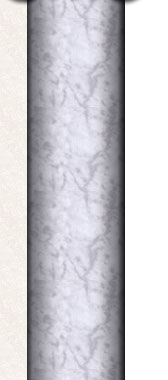





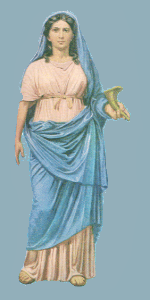 A citizen can tell how important or wealthy a person was from their clothing. Women wear a tunic (called a tunica) which is similar in look to the chiton. The tunica was usually knee-length. Over this the women typically wear a stola which is full length from neck to ankle, high- waisted and fastened at the shoulders with clasps. The stola is usually either white, brown or grey, though some were brightly colored with vegetable dyes. A shawl, called a palla, is worn wrapped around the shoulders and arm, or could be draped over the head. Cloaks were worn to keep warm.
A citizen can tell how important or wealthy a person was from their clothing. Women wear a tunic (called a tunica) which is similar in look to the chiton. The tunica was usually knee-length. Over this the women typically wear a stola which is full length from neck to ankle, high- waisted and fastened at the shoulders with clasps. The stola is usually either white, brown or grey, though some were brightly colored with vegetable dyes. A shawl, called a palla, is worn wrapped around the shoulders and arm, or could be draped over the head. Cloaks were worn to keep warm.
Women's tunics often had sleeves fastened with buckles. The over garment was often sleeveless and a cloak would be worn over it. All these garments were dyed in different colours, usually quite bright ones.
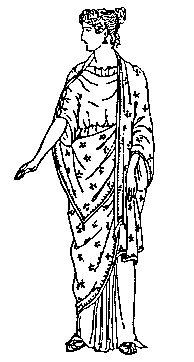
Under tunic, stola, palla |
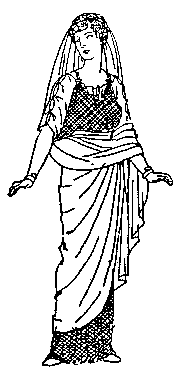
Under tunic, stola, palla |
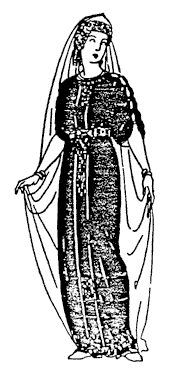
Purple stola, gold embroidery |
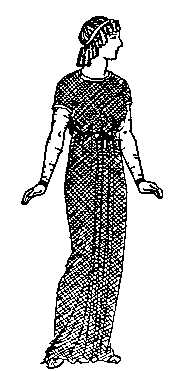
Young woman - Under tunic, stola |
Hairstyles

Women's hairstyles vary depending on vogue and sometimes could be very elaborate.
When the hair isn't thick enough for the most popular style, then wigs would be worn. (A) This complicated structure of plaits piled on top of the head was worn by young girls on their wedding day. (B) and (C) is known as the "bird's nest" or "diadem" style is considered classical for it has lasted a long time with many variations. (D) A fairly simple style. Fashionable women wore hair-pieces that were often made from the hair of slave girls.
Accessories worn by women
The women of Il Senso de Acqua love ornate necklaces, pins, earrings, bracelets and rings. Pieces made of gold (the favored metal of Il Senso) and pearls (showing their tie to the ocean) are favorites.
Parasols were used, or women might carry fans made of peacock feathers, wood or stretched linen. Women's street shoes were made of leather, like a man's. Women's sandals, though rare are usually brightly colored. Some noble ladies shoes are even decorated with pearls or other stones and precious metals.
Girls styles
Girls wore a simple tunic with a belt at the waist. When they went outside, they wore a second tunic that reached their feet.
Girls' Bulla
Children wore a special locket around their neck, given to them at birth, called a bulla. The Etruscum aurum is a gold circular amulet that is worn protectively as an amulet. It is a token of as a child needing protection and is set aside with the coming of age, as the child becomes an adult and is considered no longer in need of such protection. Girls wore their bulla until the eve of their wedding day, when their bulla was set aside with other childhood things, like her toys.
Most often the symbol on the amulet was the holy symbol of the patron deity of the family, but if a deity showed early interest in the child a new bulla would be made in honor of them with their symbol, depending on the deity and type of interest given.
